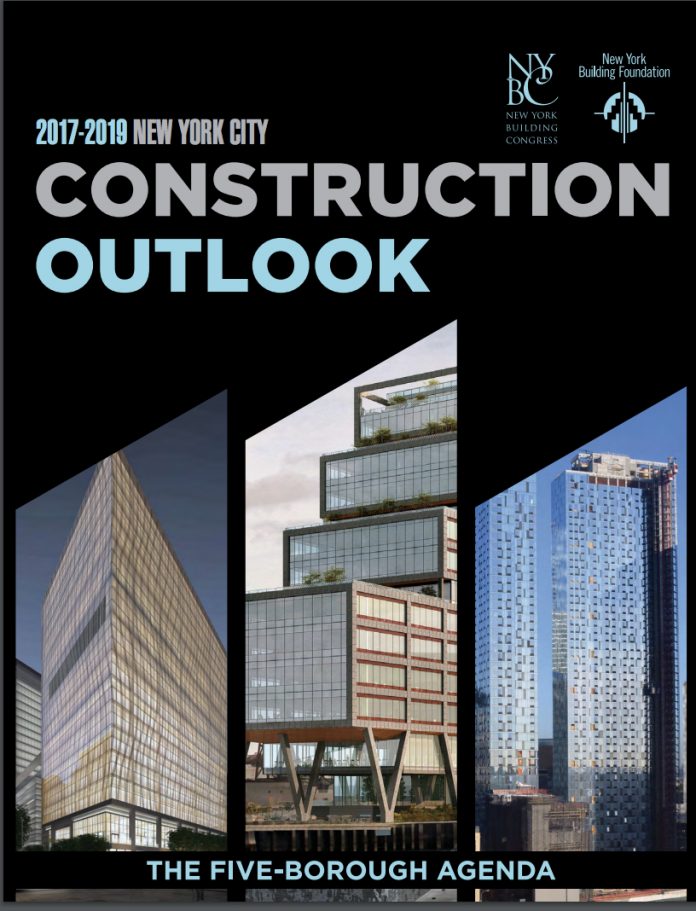New York City remains in the midst of its second and most robust building boom of the 21st century – with no end currently in sight, according to New York City Construction Outlook 2017-2019, an annual forecast and analysis prepared by the New York Building Congress (NYBC) with support from the New York Building Foundation.
The Building Congress forecasts $45.3 billion in NYC construction spending in 2017. While this would represent a 13 percent decline from 2016, when spending reached $52.2 billion, it would still be the second highest total in actual dollars in city history. It also would rank second, behind 2016, after adjusting for inflation since at least 1995. The Building Congress anticipates a quick return to last year’s heights with $52.5 billion in construction spending projected in 2018, followed by $50.1 billion in 2019.
After topping 140,000 jobs for the first time in 2016, the NYBC anticipates construction employment to increase by 3,600 to 149,800 jobs throughout the five boroughs in 2017. Employment is anticipated to climb to 151,200 jobs in 2018 before dropping back to 144,100 jobs in 2019.
“New York City’s construction industry continues to fire on all cylinders,” NYBC president and CEO Carlo A. Scissura said in a statement. “After an epic 2016, which saw New York City shatter recent highs for construction spending and employment, the three-year outlook remains white hot.”
Non-Residential
Non-residential construction spending, which includes office space, institutional development, government buildings, sports/entertainment venues and hotels, is expected to reach $17.4 billion in 2017, down from $21.6 billion a year ago. The NYBC forecasts non-residential spending to reach $22.1 billion in 2018 and $20.3 billion in 2019.
Office construction, which is at its highest levels in three decades, is the primary driver of non-residential spending. The NYBC estimates that 15 million square feet of office space will be completed in Manhattan during the three-year period, with an additional 2 million square feet of office space completed in Brooklyn and Queens.
Residential
The NYBC anticipates $11 billion in residential construction spending this year, down from $16 billion in 2016. Residential spending, which includes spending on new construction as well as alterations and renovations to existing buildings, is projected to reach $11.6 billion in 2018 and $10.6 billion in 2019.
The number of new housing units produced is forecast to reach 26,700 units this year, down from 37,700 in 2016. Looking ahead, the Building Congress predicts 24,000 new units to be built in 2018 and 22,000 units in 2019.
“Between 2015 and 2016, New York City produced an astounding 72,000 new units of housing, which was easily the most productive two-year period for residential construction in more than two decades,” Scissura said. “While the pace of new housing construction will cool in the coming years, our 2018 and 2019 projections remain strong from a historical perspective.”
Government
Government spending on public works, which includes mass transit, roads, bridges, and other essential infrastructure, is expected to reach $16.9 billion in 2017, a 16 percent increase from 2016 when spending reached $14.6 billion. Spending in this sector is anticipated to increase further to $18.8 billion in 2018 and $19.1 billion in 2019.
The City of New York is forecast to spend $8.1 billion on infrastructure in 2017, up from $7 billion spent in 2016. The NYBC anticipates city spending to increase to $9.6 billion in 2018 and $10.1 billion in 2019.
The organization foresees construction spending by the Metropolitan Transportation Authority (MTA) to increase to $6.5 billion this year from $5 billion in 2016. MTA spending is anticipated to drop to $6 billion in 2018 and $4.7 billion in 2019.
The Port Authority of New York and New Jersey is expected to invest $1.3 billion this year in New York City capital projects, down from $1.7 billion in 2016. The Building Congress estimates that Port Authority construction spending in the city will increase to $2.1 billion in 2018 and $3.1 billion in 2019.
The remaining $1.1 billion in 2017 public works spending will be undertaken by agencies on the State and Federal levels, including DASNY, the State Department of Transportation and the U.S. Army Corps of Engineers.
“Government infrastructure spending is back on the rise and not a moment too soon,” Scissura said. “After years of declining investment, our transportation and infrastructure networks are currently straining to keep pace with the additional demands imposed by a growing economy and robust private investment.”
NYBC prepared the construction outlook report with the assistance of Urbanomics, an economic consulting firm. It incorporates updated analysis from the U.S. Census Bureau, Dodge Data and Analytics, the New York State Department of Labor, public sector capital budgets and the Real Estate Board of New York. The New York Building Foundation, which is the philanthropic arm of the New York Building Congress, co-sponsored the report.

